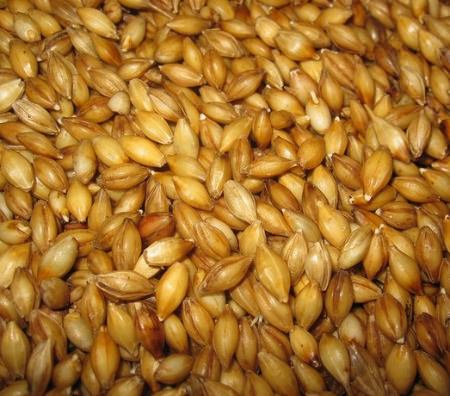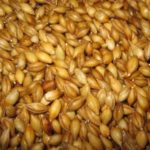 The video lesson plus written recipe features how to make sprouted grains at home and thus make your homemade sprouted flour for all your baking needs.
The video lesson plus written recipe features how to make sprouted grains at home and thus make your homemade sprouted flour for all your baking needs.
China is credited with developing the method for germinating seeds many centuries ago and on long ocean voyages, Chinese sailors used sprouted mung beans as a source of vitamin C for preventing scurvy.
Vitamin C is produced in significant quantities when you sprout seeds. It is absent from unsprouted seeds! Many other nutrients are increased substantially from sprouting grains, as I go over in the videos.
Sprouting Grain
Sprouted flour made from freshly ground sprouted grain is one of the 3 ways traditional societies used to prepare their grains before eating.
This careful preparation of wheat and other grains is necessary in order to break down the antinutrients, toxins, and difficult to digest proteins (i.e., gluten) so as to optimize digestibility and to allow maximum absorption of nutrients.
Unfortunately, this careful preparation method has been lost with our modern cooking methods which focus on speed and convenience rather than nutrient density and digestibility!
Equipment Needed to Sprout Grain
The first item you need to sprout is a half gallon size glass container with a screen lid (like this one). Many health food stores sell sprouting jars, but you can easily make one yourself at home using a glass jar and a clean pair of pantyhose cut to fit the lid of the jar and fastened with a rubber band.
Once you have your jar ready, fill it no more than halfway with the grain you wish to sprout. I use organic spelt or organic soft white wheat that I obtain from my local grain co-op. For other ideas, visit my Resources page.

Sprouting Grains Recipe
How to sprout grains at home easily and cost effectively that will improve the nutrient value of your baked goods. Recipe can be used to sprout any types of grain.
Instructions
-
Place the wheat berries in the sprouting jar and affix the screen lid.
-
Rinse and drain the wheat grains several times with filtered water until the berries are completely wet.
-
Fill the jar until almost full with water and let the berries soak overnight on the kitchen counter.
-
The next morning, tip the jar and drain out the water using the screen lid to prevent the berries from spilling out. Rinse the wheat one more time and then invert the jar and let it sit at an angle to facilitate draining and allowing the circulation of air.
-
Rinse the wheat one more time and then invert the jar and let it sit at an angle to facilitate draining and allowing the circulation of air. I use my grain grinder as a support for the jar so that the draining occurs right over the kitchen sink.
-
Every few hours, rinse the wheat again and reset the jar in the draining position.
-
In anywhere from a few hours to a few days (depending on the time of year and warmth/humidity in your home), small white buds will appear on the ends of the wheat kernels. See the picture for what it should look like.
-
When this occurs, pour the sprouted wheat kernels into baking pans and place in a dehydrator or a warm oven (150 F/ 66 C) for about 24 hours until fully dried.
-
Store the sprouted grains in an airtight container in the refrigerator, or grind immediately and then freeze the sprouted flour. Use sprouted flour just like you would use regular flour in your favorite baking recipes.
Sprouted Grain Recipes to Try
Baked goods made with sprouted flour are much more digestible/filling. As a result, you will find that you eat much less of the same item when you use sprouted flour!
Try making this sprouted flour pizza crust or these sprouted flour brownies with your sprouted flour!
Where to Find Organic or Already Sprouted Grain
If after watching these two short videos on sprouted grains below you have interest in trying your hand at making your own sprouted flour for baking, please visit my Resources page for where to buy quality sprouted grains for grinding into fresh sprouted flour (my favorite is einkorn … completely unhybridized wheat) or to locate suppliers of organic grain for making sprouted grains at home yourself.
How to Make Sprouted Grains (Videos)
The two videos below demonstrate how to sprout grains. The first video shows the soaking process and the second the sprouting process.
Sarah, The Healthy Home Economist
More Information
Teff Grains (sprouted or not) Deliver Big on Nutrition
Amaranth: Superfood of the Aztecs








Three things:
One, thank you so much for all the time you put into helping others learn the things you have found. You are heaven sent for me, an earthly angel giving me verification of many things that I suspected but couldn’t verify. From more info on raw milk (previous knowledge that you added to) to fats (personal theory now verified and added to) and now the traditional preparation of grains and legumes (totally new knowledge that make so much sense!) I am so very grateful for a loving God who placed your website in my path for me to stumble over. I love when that happens!
Two, could this soak, sprout, dry, and grind method work for corn as well? (thinking cornmeal for cornbread).
And three, I have a recipe for the most amazing whole wheat sourdough bread, I can’t wait to see how it works out with the sprouted flour! It’s from an awesome website that teaches how to make your own sourdough starter (never had one work from scratch before this method, and it doesn’t use yeast to start it!) I will try to remember to post it for monday mania (?) for anyone who might be interested.
Thanks SO much! Paige
Are there any commercially available breads that are made using traditional methods? I admire your dedication to wholesome ideals, but I don’t have the time to do all this at this point of my life. Maybe someday. I know you don’t encourage shortcuts, but I really could use some.
i saw your vidieo that how to prepare the sprouted flour.it is very good. I have a doubt that i was preparing this flour by this method that after i sprouted the grain i use to fry it on a pan drily then i wlll grind it. is this right method ?because of frying the grains in a pan is all the nutrients will destroy .please clarify this doubt.
Sarah, would you sprout grain and then soak it to after you made the flour? Also, can you use buttermilk from the store to soak your pancake flour over night or must it go in the frig?
Hi, I was watching your videos on sprouting, my comment is can you make a video on making bread after you grind your flour? I didn’t see one on that, I did see the one on you making pancake dough. I like all your videos. I’ve tried to make bread from scratch with regular flour that didn’t turn out right. Can you do a video on making loaf bread after you grind your seeds step by step. Also do you know a name of a book i can buy that have different kinds of recipes using sprouting seeds or a website I can go to . The bread I buy from the store make me gain weight. I’m looking for something more healthy and easier. Thank you for explaining why certain foods are not good for us to eat and the side affects that comes along with these different foods. Keep bringing us more info. Thank you
Doesn’t baking the sprouted grains reduce the vitamin content?
Yes…heat destroys vitamin C. But it is still more digestible grain wise. The vitamin C factor seems sort of null and void though.
Hi Sarah:
First, let me express my complete gratitude for all that you have done to share this information. You have no idea what this means to me and my family.
I would like to know if it is possible to store the dehydrated sprouted grain for any length of time. Can I store it in a canning jar by removing the air with a FoodSaver attachment? I would like to make a BIG batch of this and save it for future use.
Thanks for your help.
Blair
Do you have any experience/knowledge of the rustic / “no knead” method of making yeast breads? In this method you use on 1/6 to 1/4 the standard amount of yeast, and make a moist dough that you let rise 18 hours before shaping. My experience is that it yields a bread that’s very like sourdough in texture, though not particularly sour to the taste. I’m wondering if the long rising time allows some fermentation to take place, perhaps making such bread a “best of both worlds”. It certainly makes a fine load of bread, though perhaps not by your criteria. I’d be interesting in anything you might have to say about this method. Thanks.
I am curious about gluten. My husband has a gluten intolerance and we are completely gluten free. I have some hard red wheat berries that we sprout for wheatgrass. If I sprout them and grind them down, would I be able to use it for normal bread recipes? I thought that the gluten was gone after sprouting but what does that do to the bread?
After watching your video I’m curious about the chemistry of the sprouting process. How is it that you can get vitamin c after sprouting grains when there is no vitamin c to start with?
Sarah, If you mentioned this in your video I missed it.
How much wheat berry should you start out with to wind up with say a cup of sprouted-grain flour? Hope that makes sense!
Thanks!